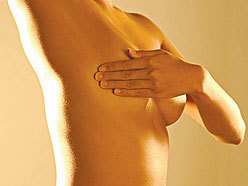
Breast defence
Some women have specific genetic problems but those breast cancers number less than 10% of all. One expert recently told me that breast cancer causes are “multifactorial” and that the combination of lifestyle factors and genetic vulnerabilities that accounts for the abnormal growth of cells is still being figured out.
That means that most of the 22,700 Canadian women (and 180 men) expected to be diagnosed this year won’t even know what caused their illness. Neither will the 5,400 women who die from it. Sometimes we forget just how many different factors may contribute to breast cancer’s development. Here’s what’s known:
ESTROGEN
The more estrogen a woman makes over time or takes through post-menopausal combined hormone replacement therapy, the higher her risk for getting breast cancer. The more years a woman menstruates, the longer breast tissue is estrogen-exposed. Birth control pills only slightly increase risk.
AGE
The chance of getting breast cancer increases as a woman ages. According to Dr. Love, from 20 to 30 the risk is one in 2,000; from 40 to 49 the risk is one in 68; from 60 to 69 the risk is one in 26. After the age of 70, a woman has a one-in-eight chance of getting breast cancer.
ALCOHOL
The risk of breast cancer jumped by 30% in women who drank more than three drinks daily.
FAMILY HISTORY
Having a mother, sister or daughter with breast cancer almost doubles a woman’s risk, particularly if the relative was diagnosed before age 50. A family history of ovarian cancer also increases the risk of developing breast cancer.
RADIATION
Radiation therapy for a previous cancer heightens the risk of breast cancer. The risk is highest if there was chest radiation during puberty.
OBESITY
Post-menopausal women who are obese are more at risk; fat cells play a role in estrogen production so being overweight adds to risky estrogen exposure.
GENETIC MUTATIONS
Those who have inherited changes in the BRCA1 and BRCA2 genes have a higher risk (some up to 90%) of getting the disease, and possibly at a younger age. Many other genes are also associated with breast cancer, including the HER-2/neu oncogene.
ENVIRONMENT
We’re exposed to vast amounts of hormone-mimicking and cell-interrupting chemicals in products we use and through environmental pollutants, some of which increases the risk of breast cancer.
BREAST DENSITY
Dense breast tissue, as shown on a mammogram, increases your risk. One study published in the Journal of the National Cancer Institute found that the relative risk of developing breast cancer in post-menopausal women with dense breasts was 400% higher than in women with fatty non-dense breasts.
BREAST DISEASE
Some diseases, including hyperplasia, can increase breast cancer risk by up to four-fold.
Breast defence , Breast defence Health, Breast defence Health Latest, Breast defence Health Information, Breast defence Health information, Breast defence Health Photo,Breast defence for Weight Health photo, Breast defence Health Latest, Breast defence Health latest, Breast defence for Weight Health Story, Breast defence Video, Breast defence video, Breast defence Health History, Breast defence Health history, Breast defence over Picture, history, Breast defence Asia, Breast defence asia, Breast defence Gallery, Breast defence for Weight gallery, Breast defence Photo Gallery, Breast defence Picture, Breast defence picture, Breast defence Web, Malaysia Health, web Health, web Health picture, video photo, video surgery, gallery, laparoscopy, virus, flu, drug, video, Health Health, calories, photo, nutrition, health video, symptoms, cancer, medical, beating, diet, physical, Training, organic, gym, blister, exercise, weightloss, surgery, spiritual, eating, tips, skin, operation, bf1,
